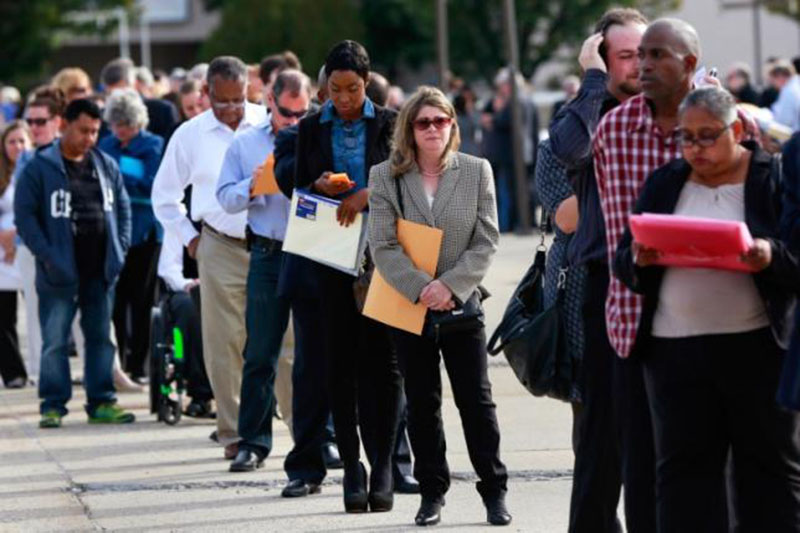US job growth slows, but wages rebound strongly
WASHINGTON: US employment increased less than expected in December but a rebound in wages pointed to sustained labor market momentum that sets up the economy for stronger growth and further interest rate increases from the Federal Reserve this year.
Nonfarm payrolls rose by 156,000 jobs last month, the Labor Department said on Friday. The gains, however, are more than sufficient to absorb new entrants into the labor market.
Fed Chair Janet Yellen has said the economy needs to create just under 100,000 jobs a month to keep up with growth in the work-age population. Employers hired 19,000 more workers than previously reported in October and November.
"With wages on the rise and payrolls solid, the Fed is no doubt taking a healthy celebratory lap, feeling confident after this morning's report in their decision to hike in December, and cautiously optimistic as they look out to the new year," said Lindsey Piegza, chief economist at Stifel Fixed Income in Chicago.
The economy created 2.16 million jobs in 2016. Average hourly earnings increased 10 cents or 0.4 percent in December after slipping 0.1 percent in November. That pushed the year-on-year increase in earnings to 2.9 percent, the largest gain since June 2009, from 2.5 percent in November.
The unemployment rate ticked up to 4.7 percent from a nine-year low of 4.6 percent in November. Still, it remained below 4.8 percent, the Fed's estimate of the natural rate of unemployment, for two straight months. Economists had forecast payrolls rising by 178,000 jobs last month.
The dollar DXY rose against a basket of currencies on the data. Stocks on Wall Street ended higher, with the Standard & Poor's 500 index hitting a record high and the Dow Jones industrial average flirting with the 20,000 mark.
Prices for US Treasuries fell, with the yield on the 30-year bond US30YT=RR rising to 3 percent.
A broad measure of unemployment that includes people who want to work but have given up searching and those working part-time because they cannot find full-time employment fell one-tenth of a percentage point to 9.2 percent, the lowest rate in more than 8-1/2 years.
Other data on Friday showed the trade deficit widening 6.8 percent to $45.2 billion in November as imports rose to their highest level in over a year on rising oil prices.
FACTORY JOBS INCREASE
The employment report added to data ranging from housing to manufacturing and auto sales in suggesting that President-elect Donald Trump is inheriting a strong economy from the Obama administration. The labor market momentum is likely to be sustained amid rising business and consumer confidence.
Trump, who takes over from President Barack Obama on January 20, has pledged to increase spending on the country's aging infrastructure, cut taxes and relax regulations. These measures are expected to boost growth this year.
"The report, the last one for the Obama administration, cements the president's legacy of helping bring the country out of the Great Recession," said Robert Murphy, an economics professor at Boston College.
A total of 11.3 million jobs were created during Obama's term in office. Trump's proposed expansionary fiscal policy stance could, however, increase the budget deficit.
That, together with faster economic growth and a labor market that is expected to hit full employment this year could raise concerns about the Fed falling behind the curve on interest rate increases. Last month's wage growth left it just shy of the 3.0 percent to 3.5 percent range that economists say is needed to lift inflation to the Fed's 2.0 percent target.
"This is coming well before any fiscal stimulus hits. It plays to the idea that the Fed may already be behind the curve, not least because the impetus from lower oil prices has turned more inflationary as well," said Alan Ruskin, FX Research head at Deutsche Bank in New York.
The US central bank raised its benchmark overnight interest rate last month by 25 basis points to a range of 0.50 percent to 0.75 percent and forecast three rate hikes this year.
Employment growth in 2016 averaged 180,000 jobs per month, down from an average gain of 229,000 per month in 2015. The slowdown in job growth is consistent with a labor market that is near full employment. More employers, especially in the construction sector, are reporting difficulties finding qualified workers.
"The pool is all but drained especially for skilled workers. We can't bring factory jobs back because there's no one out there to run them," said Chris Rupkey, chief economist at MUFG Union Bank in New York.
The labor force participation rate, or the share of working-age Americans who are employed or at least looking for a job, rose one-tenth of a percentage point to 62.7 percent in December.
It remains near multi-decade lows in part as baby boomers retire. December's job gains were broad, with manufacturing payrolls rising 17,000 after declining for four straight months.
Construction payrolls fell 3,000 in December, likely because of cold weather, after three consecutive months of increases.
Retail sector employment rose 6,300 after increasing 19,500 in November. Further gains are likely to be limited after department store giant Macy's this week said it planned to cut 10,000 jobs starting this year.
Department stores have suffered from stiff competition from online rivals including Amazon.com. Temporary help declined 15,500 last month, the biggest drop since January.
Healthcare and social assistance employment rose 63,300. Restaurants and bars hired 29,600 workers. Government payrolls increased 12,000 in December.






